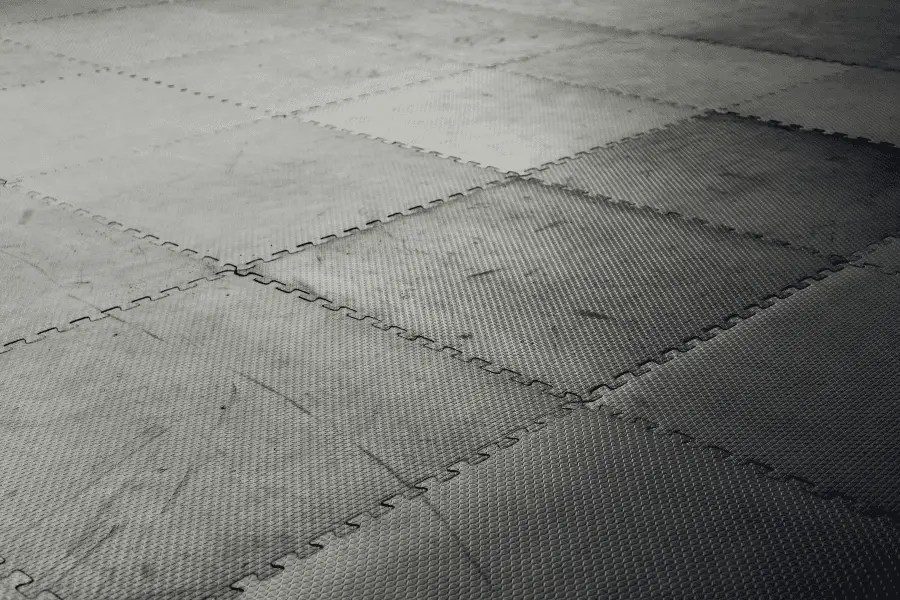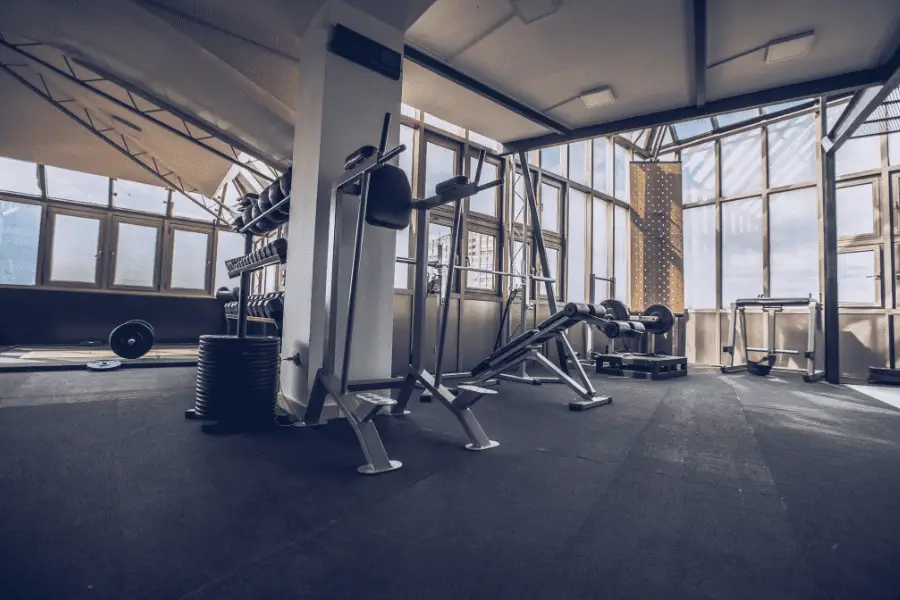Many home gyms are built in the garage or basement and often these spaces have bare concrete floors. Or maybe you’re using another space you’ve taken the flooring out of so it doesn’t get torn up. Concrete is already strong and it doesn’t really matter if you scratch it up a little bit. Do you need to have gym flooring on top of the concrete or is this not necessary?
1/4” to 3/8” thick rubber mats are best to cover a concrete floor of a home gym. Working out on bare concrete can be noisy and unhygienic as well as damage the floor and equipment. Gym Flooring also helps extend the lifespan of some equipment and prevents it from moving around when used.
But let’s not forget about the all-important question: Do you really need gym flooring on top of your concrete floor? While concrete itself is undeniably strong, there are several reasons why adding gym flooring is a smart move. Let’s explore the benefits and discover why it’s worth considering for your home gym setup.
Contents
Does a Concrete Floor Need Gym Flooring?
What happens if you just put gym equipment on a bare concrete floor and start working out on it? Well, for the most part, not all that much but it depends on what you’re doing exactly. There are some key areas why gym flooring is a good idea at least at some spots on a concrete floor.
You can find the best workout room flooring by clicking here.

In most cases a concrete floor won’t be damaged much from putting some gym equipment on it. It might scuff but most people don’t really care about that anyways unless it’s a nice polished concrete floor. One exception is if you drop heavy weights on the floor, especially if those weights are bare metal. Continuous metal on concrete impacts will damage both the floor and the weights. If you have rubber coated weights, the floor will be OK but the rubber will deteriorate much faster and after a while you’ve got bare metal weights again. So to protect your weights and your floor, some gym flooring over the concrete slab is a good idea.
Most equipment doesn’t care that much what type of flooring it’s put on. Something like a power rack or squat stands are actually better put on a solid floor than something that has some give. However, there are a few pieces of equipment that do care.
Mainly things with moving parts and electronics like treadmills and elliptical trainers can care. Concrete is a bit more difficult to clean than gym flooring and more dirt and dust collects on them in general. Gym equipment with moving parts is usually negatively affected by dirt and dust since it gets into the motors, bearings, pivot points and electronics. This can cause all kinds of issues. Dirt and dust buildup is one of the main reasons for that type of equipment failing prematurely. Gym flooring is raised a little which means less dust and dirt makes it on there and it’s easier to clean as well.
Read more on what treadmills can do to your floor here.
Gym flooring is also easier to clean than concrete which is a plus. Working out makes you sweat and good gym flooring is waterproof. That means it’s easy to get rid of sweat which can otherwise build up over time with all the nasty smells and other bad things that come along.
Another issue is grip. It depends on the finish of your specific concrete floor how slippery it is but gym flooring almost always provides more grip which is a good thing when you have heavy things in your hands or on your back. And don’t forget that equipment needs grip as well. Especially cardio equipment like a treadmill or elliptical can have the tendency to ‘walk’ a little if there is no good grip on the floor.
And finally, concrete is hard. That means noises bounce off and everything you drop on the floor has a much sharper impact which means it can get loud. Dropping a barbell with weights on a concrete floor can make quite a racket especially with metal plates. A gym floor will absorb a lot of the impacts and noise which makes the gym more comfortable to use for yourself but also people around you. Having a slightly softer floor is also more comfortable for bodyweight exercises and stretching.
Cover The Whole Concrete Slab?
Gym flooring can be pricey if you get the good quality stuff. And garages/basements are often quite large. Is it necessary to cover every square inch of floor with rubber?
It’s not necessary to cover the whole concrete floor with gym flooring in most cases. It does make your gym easier to clean, quieter and protects your equipment as well as the floor but, there are spots where it’s more necessary than others.
The main places it’s necessary to have something to cover the concrete is the place where stand while weightlifting, where your weights hit the floor and under cardio machines. Those locations benefit the most from having some kind of flooring.
You won’t get the full noise damping and hygiene effects but there will still be some. If you don’t cover the whole floor but only certain spots, you do have to be mindful of the edges. It creates a little ledge that you could trip over. As long as you’re aware this isn’t really an issue but accidents happen.
Covering the whole floor or at least the part of the floor where all the gym equipment is looks much nicer but if that’s worth the extra money is up to you.
What Type Of Gym Flooring Goes Over Concrete?

Does it matter what kind of gym flooring you use to put on top of concrete? Do you need something special?
In most cases normal gym flooring is perfectly fine to put on top of concrete. Foam tiles are relatively cheap but I would avoid them for on top of concrete. They are light and tend to slide around unless you lay them from wall to wall so there is nowhere to go. You can use some foam tiles on top of a rubber mat in places where you want some extra impact damping. For example in the place where you deadlift.
Alternatively you can build a weightlifting platform around your power rack which does basically the same thing as a rubber mat although the used rubber is usually thicker.
Rubber mats are a much better option for concrete floors. Rubber is grippier and heavier than foam times and therefore doesn’t tend to slide around nearly as much if at all. And mats are usually so heavy, they really don’t slide. Rubber also much nicer looking and lasts longer.
If your concrete floor is smooth and doesn’t have any bumps/holes, a thin rubber mat (1/4”) is OK. You’ll get most of the benefits although as mentioned above, you might want to add a foam tile to the spots where your weights hit the floor.
Find my recommendations for gym flooring here.
In case your floor is a little rough, a thicker rubber mat (3/8”)can help smooth out some of that unevenness. Don’t expect to even out 2” bumps but if it’s just slightly rough, a bit thicker mat is good.
